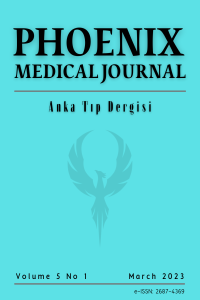Toraks Travmalı Olgularda Travma Mekanizmasının Vertebra Fraktürü Eşlik Etme Sıklığına Etkisi
Acil servis, toraks travması, vertebra fraktürü
The Effect of Trauma Mechanism on the Frequency of Accompanying Vertebral Fracture in Cases with Thoracic Trauma
Emergency department, thoracic trauma, Spinal Fractures Acil servis, toraks travması, toraks travmalarında vertebra fraktürü.,
___
- Afacan MA, Büyükcam F, Çavuş UY, Kesim A, Cevik M,Yilmaz MS et al. Investigation of Blunt Thoracic Trauma Cases Admitted to the Emergency Department. Kocatepe Medical Journal. 2012;13(1): 1-7.
- Wang H, Zhou Y, Ou L, Li C, Liu J, Xiang L. Traumatic Vertebral Fractures and Concomitant Fractures of the Rib in Southwest China, 2001 to 2010 An Observational Study. Medicine. 2015;94(44):1-6.
- Dübüş T. Evaluation of 134 Cases with Thorax Trauma. Turkish Thoracic Society. 2012;13:56-9.
- Alvi MA, Kapurch II JR, Ivanov DV, Kerezoudis P, Bydon M, Freedman BAI. Does the Coexistence of Multiple Segmental Rib Fractures in Polytrauma Patients Presenting With “Major” Vertebral Fracture Affect Care and Acute Outcomes? J Orthop Trauma. 2019;33:23–30.
- Vioreanu MH, Quinlan JF, Robertson I, O’Byrne JM. Vertebral fractures and concomitant fractures of the sternum. International Orthopaedics(SICOT). 2005;29:339–342.
- Morgenstern M, Rüden CV, Callsen H, Friederichs J, Hungerer S, Bühren V, et al. The unstable thoracic cage injury: The concomitant sternal fracture indicates a severe thoracic spine fracture. Injury. 2016;47(11):2465-2472.
- Katsuura Y, Osborn JM, Cason GW. The epidemiology of thoracolumbar trauma: A meta-analysis. J Orthop. 2016;13:383–8.
- Meldon SW, Moettus LN. Thoracolumbar spine injuries: clinical presentation and the effect of altered sensorium and major injury. J Trauma. 1995;36:1110–4.
- Singh R, Taylor DM, D’Souza D, Gorelik A, Page P, Phal P. Injuries significantly associated with thoracic spine fractures: A case–control study. Emergency Medicine Australasia. 2009;21:419–423.
- Wang H, Xiang Q, Li C, Zhou Y. Traumatic Vertebral Fractures with Concomitant Fractures of the First Rib. Orthopaedic Surgery. 2013;5:100–104.
- Liu B, Zhu Y, Liu S, Chen W, Zhang F, Zhang Y. National incidence of traumatic spinal fractures in China: Data from China National Fracture Study. Medicine (Baltimore). 2018;97(35):e12190.
- Hanna TN, Zygmont ME, Harmouche E, Salastekar N, Johnson JO, Khosa F. Association of lumbar fractures, abdominal aortic calcification, and osteopenia. Clin Imaging. 2015;39:662–6.
- VandenBerg J, Cullison K, Fowler SA, Parsons MS, McAndrew CM, Carpenter CR. Blunt Thoracolumbar-Spine Trauma Evaluation in the Emergency Department: A Meta-Analysis of Diagnostic Accuracy for History, Physical Examination, and Imaging. J Emerg Med. 2019;56(2):153-165.
- Fernández-de Thomas RJ, De Jesus O. Thoracolumbar Spine Fracture. 2022 Aug 22. In: StatPearls [Internet]. Treasure Island (FL): StatPearls Publishing; 2022 Jan–. PMID: 32965875.
- Senturk E, Dogan Y, Yoldas E. Thorax Trauma; Analysis of 1142 Cases. Turkish Thoracic Society 2010; 11:47-54.
- Yayın Aralığı: Yılda 3 Sayı
- Başlangıç: 2019
- Yayıncı: İbrahim İKİZCELİ
Çörek Otu Yağının Bilimsel ve Sağlıklı Yaşam Üzerine Tıbbi ve Terapötik Etkileri
Mohamad EL DHAYBİ, Deniz MESUTOĞLU, Dilara Rana BİÇER
Anestezistler İçin Radyasyon Güvenliği
Ayla ESİN, Yasemin ÖZŞAHİN, Kerem ERKALP, Ziya SALİHOĞLU
Delici – Kesici Alet Yaralanmalarının Demografik Özellikleri
Ali ŞAHİN, Eren USUL, Yıldız YILDIRIMER, Emrah ARI, Ali HALICI, Engin Deniz ARSLAN
Pons Lezyonlarının İki Nadir Prezentasyonu: Bir Buçuk Ve Sekiz Buçuk Sendromu
Turgay DÖLEK, Ayşe Özlem AKGÜN, Vedat Semai BEK, Gülnihal KUTLU
Pakistan Seli: Ruhsal Hastalık Krizinin Yaygınlığı Endişe Verici Bir Durum
Yousra SARFARAZ, Ammara RAFİQUE, Nida SOHAİL
Kardiyopulmoner Resüsitasyon Eğitimine Etki Eden Faktörler: Sakarya Örneği
Nuray ASLAN, Necip Gökhan GUNER, Yeşim DURGUN, Ensar DURMUŞ, Yusuf YURUMEZ
Toraks Travmalı Olgularda Travma Mekanizmasının Vertebra Fraktürü Eşlik Etme Sıklığına Etkisi
Beliz ÖZTOK TEKTEN, Osman YAKŞİ
Acil Serviste SII ve SIRI değerlerinin CO Zehirlenmesinin Şiddetini Tahmin Etmedeki Rolü
Barış ÇİL, İbrahim DEMİR, Mehmet KABAK, İclal HOCANLI, Mahsuk TAYLAN, Mustafa FİDANTEN
